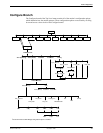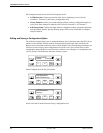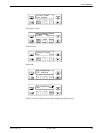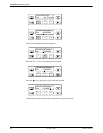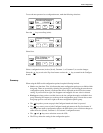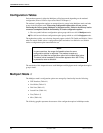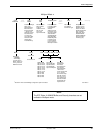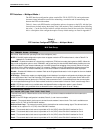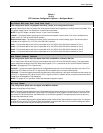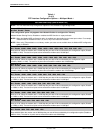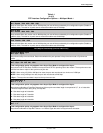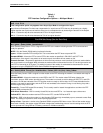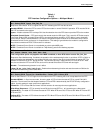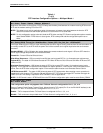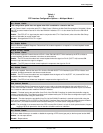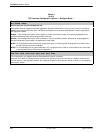
DCP Configuration
4-113920-A2-GN31-30 November 1996
Table 4-1
(2 of 9)
DTE Interface Configuration Options — Multiport Mode l
Bakup_TXClk_Src: Internal
Nxt Internal RXC_Loop Port1 Port2 Port3 Port4
This configuration option only appears when Dual_Leased_Ln is configured for Enable.
Backup Transmit Clock Source. Selects the clock reference source when operating in the Dual Leased Line Mode. This
is a special mode in which one leased line is used to back up another.
NOTE: If the DTE Bridge is enabled, Ports 2, 3, and 4 are not available.
Internal – The transmit data’s clock source is derived from the modem’s internal clock. This clock is available as an
output on Pin 15 (TXC) of the EIA-232-D interface.
Receive Clock Loop
– The modem’
s transmit clock is derived from its received analog signal. The derived clock is
available as an output on Pin 15 (TXC) of the EIA-232-D interface.
Port1 – The transmit data’s clock source is provided on Pin 24 (XTXC) of the EIA-232-D interface for Port 1.
Port2 – The transmit data’s clock source is provided on Pin 24 (XTXC) of the EIA-232-D interface for Port 2.
Port3 – The transmit data’s clock source is provided on Pin 24 (XTXC) of the EIA-232-D interface for Port 3.
Port4 – The transmit data’s clock source is provided on Pin 24 (XTXC) of the EIA-232-D interface for Port 4.
CT111_Rate Cntl: Disable
End Disable Fallback1 Fallback2
This configuration option does not appear when V.34 is enabled for a leased or dial line.
CT111 Rate Control. Allows the DTEs to control modem rate via Pin 23 of the EIA-232-D interface. This configuration
option determines the effect of the DTE Rate control signals. CT111 is also known as CH on the EIA-232-D interface.
Disable – Disregards all CT111 Rate Control.
Fallback1 – Forces the modem to decrease its configured data rate to the next lower data rate when any of the CT111
signals are OFF. When all of the CT111 signals are ON, the modem returns to its previous data rate.
Fallback2 – Forces the modem to decrease two data rates (while remaining in the same modulation scheme) when any
of the CT111 signals are OFF. When all of the CT111 signals are ON, the modem returns to its previous data rate. Note,
Fallback2 is not available for TMp tributaries.
NOTE: For proper CT111 operation, disable the Autorate configuration option.
MSD Port Control: Host
Nxt Host Modem
This configuration option does not appear when MSD is disabled.
Modem Sharing Device Port Control.
Host – The host computer determines the polling sequence that controls which port transmits at any given time. When
the DTE/DCE equipment attached to a port raises RTS (Request-to-Send) it gets to use the channel. If more than one
port raises RTS at the same time, the transmission on the channel is garbled. The system protocol ensures that only
one port transmits data at a time.
Modem – The modem determines the polling sequence that controls which port transmits at a given time. The first port
to raise RTS will receive CTS (Clear-to-Send) authorization to transmit data. When the current transmitting port lowers
its RTS, the modem randomly polls another port with RTS raised.



